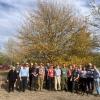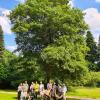Editor's Picks
Plant Focus
To create an account click here; if you have already registered, click here to become a member.
Individual articles can be purchased for U$S 10. If you would like to purchase an article, email a request to website@internationaloaksociety.org
Roderick Cameron
Published May 2023 in International Oaks No. 34: 71–80
Abstract
The research behind this paper was provoked by a notification that the name Quercus frainetto would change to Q. conferta. Why do oak names change and what are valid reasons for changing them? To answer these questions, a survey of selected changes to oak names that occurred in the past is presented. Sometimes a bad name must be rejected, or a good name must be conserved; mistakes of the past must be corrected; a deeper knowledge of certain oaks requires that new names be applied; some nomenclatural problems have still to be resolved and others may not have been resolved in the best way. Returning to the original issue: if the objective is to avoid confusion and maintain stability of plant names, should we accept the name change for what we have for many years known as Q. frainetto?
Keywords
botanical nomenclature, principle of priority, name changes, Quercus frainetto, Q. conferta
References
Ascherson, P. and P. Graebner. 1911. Synopsis der Mitteleuropäischen Flora 4. Leipzig: Verlag von Wilhelm Engelmann.
Bartha, D. 2021. A magyar tölgy (Quercus conferta Kit.) névadásának és leírásának viszontagságos története, az érvényes név felülvizsgálata és megváltoztatása. Botanikai Közlemények 108(2): 97-133.
Buckley, S.B. 1861. Description of Several New Species of Plants. Proceedings of the Academy of Natura Sciences of Philadelphia 1860: 443-445.
Buckley, S.G. 1881. Quercus rubra var. texana. Proceedings of the Academy of Natura Sciences of Philadelphia 1860: 123-124. Camus, A. 1932. Quelques espèces nouvelles de Chênes. Bulletin du Muséum national d'histoire naturelle, ser. 2, 4: 124.
Cameron, R. 2023. Proposal to conserve the name Quercus frainetto against Q. conferta (Fagaceae). Taxon 72(1): 211-213. https://dx.doi.org/10.1002/tax.12868.
Coke, E. 1628. The First Part of the Institutes of the Lawes of England. London: Adam Islip for the Societie of Stationers.
De Candolle, A.P. 1864. Quercus candicans. In Prodromus systematis naturalis regni vegetabilis, edited by A.P. De Candolle, 16(2): 75.
Dorr, L.J., and K.C. Nixon. 1985. Typification of the Oak (Quercus) Taxa Described by S. B. Buckley (1809-1884). Taxon 34(2): 211-228. Engelmann, G. 1876. About the Oaks of the United States. Transaction of the Academy of Science St. Louis 3: 372-400.
Franco, J.A., and G. López. 1987. Notas referentes al género Quercus. Anales Jardín Botánico de Madrid 44(2): 555-558.
Govaerts R., and M. Avishai. 2000. The conserved type of the name Quercus pubescens Willd. (Fagaceae). Taxon 49(3): 537.
Hardin, J.W. 1979. Quercus prinus L.—nomen ambiguum. Taxon 28(4): 355-357.
Huang, C., Y. Zhang, and B. Bartholomew. 1999. In Flora of China: Cycadaceae through Fagaceae 4, edited by Z.-Y. Wu, and P.H. Raven, pp. 314-400. Beijing/St. Louis: Science Press/Missouri Botanical Gardens Press.
Jackson, D. 1895. Index Kewensis Part 4. Oxford: Clarendon Press.
Knowlton, F.H. 1900. Fossil Plants Associated with the Lavas of the Cascade Range. Twentieth Annual Report of the United States Geological Survey, 1898-1899, Part III: 37–58.
Lamant, T., and G. Sternberg. 2000. Homonyms, Synonyms, and Frustrations: An Introduction to the Name Problems of Oaks. International Oaks 10: 6-12.
Linnaeus, C. 1751. Philosophia Botanica. Stockolm: G. Kiesewetter
Linnaeus, C. 1753. Species Plantarum Vol. 2. Stockholm: Lars Slavius.
McCauley, R.A., and K. Oyama. 2020. A re-evaluation of taxonomy in Quercus section Lobatae subsection Racemiflorae (Fagaceae), resurrection of the name Q. pennivenia and description of a new taxon, Q. huicholensis. Phytotaxa 471(3): 247-257.
Miquel. F.A.W. 1855–60. Flora van Nederlandsch Indië. Amsterdam: C.G. van der Post
Muller, C.H. 1942 The Central American Species of Quercus. Washington: United States Dept. of Agriculture. Née, L. 1801. Descripción de varias especies nuevas de Encina (Quercus de Linneo). Anales Ci. Nat. 3(9): 277.
Nixon, K.C., and C.H. Muller. 1994. New Names in California Oaks. Novon 4(4): 391-393.
Nixon, K.C., and F.R. Barrie. 2017. Three Previously Undescribed Species of Quercus (Fagaceae) from Mesoamerica and the Designation
of a Lectotype for Q. acutifolia. Novon: A Journal for Botanical Nomenclature 25(4): 444-450.
Palmer, E.J. 1927. On Nuttall’s Tail Through Arkansas. Journal of the Arnold Arboretum 8: 24-55.
Sabato, S. 1990. Remarks on the Publication Dates of Tenore’s Flora Napolitana. Taxon 39(3): 409-416.
Schottky, E.M. 1912. Die Eichen des extratropischen Ostasiens und ihre pflanzengeographische Bedeutung. Botanische Jahrbücher für Systematik, Pflanzengeschichte und Pflanzengeographie 47(5): 617-708.
Schultes J.A. 1814. Österreichs Flora. Ein Handbuch auf botanischen Excursionen, enthaltend eine kurze Beschreibung der in den Erbstaaten des österreichischen Kaiserthumes wildwachsenden Pflanzen. Vienna: C. Schaumburg und Compagnie.
Schwarz. O. 1935. Nomenclature of some British and German Oaks. Journal of Botany, British and Foreign 73: 49-51. Schwarz, O. 1937. Monographie der Eichen Europas und des Mittelmeergebietes. Berlin:
Seemann, B.C. 1852-57. Botany of the Voyage of H.M.S. Herald, under the Command of Captain Henry Kellett, R.N., C.B., during the years 1845-1851. London: Lovell Reeve.
Soldano, A. 1993. Nuovi dati nomenclaturali su piante della flora italiana e mediterranea. Atti della Società di Scienze Naturali e del Museo Civico di Storial Naturale di Milano 133(10): 113-118.
Spellenberg, R., and J.R. Bacon. 1996. Taxonomy and distribution of a natural group of black oaks of Mexico (Quercus, section Lobatae, subsection Racemiflorae). Systematic Botany 21(1): 85-99.
Tenore, M. 1815. Synopsis novarum plantarum, quae in Prodromo Florae Napolitanae, anno 1811–13 edito, describuntur, In Ad Catalogum plantarum Horti regii neapolitanii anno 1813 editum. Appendix prima. Naples: Typographia Amuliana.
Trelease, W. 1921. A natural group of unusual black oaks. Proceedings of the American Philosophical Society 60: 31-33. Trelease, W.L. 1924. The American Oaks. Memoirs of the National Academy of Sciences. 20: 1-255.
Turland, N.J., J.H. Wiersema, F.R. Barrie, W. Greuter, D.L. Hawksworth, P.S. Herendeen, S. Knapp, et al. (eds.). 2018. International Code of Nomenclature for algae, fungi, and plants (Shenzhen Code) adopted by the Nineteenth International Botanical Congress Shenzhen, China, July 2017. Regnum Vegetabile 159. Glashütten: Koeltz Botanical Books.
Valencia-Ávalos, S., G. Flores-Franco, and J. Jiménez-Ramírez. 2015. A nomenclatural revision of Quercus acutifolia, Q. conspersa and Q. grahamii (Lobatae, Fagaceae). Phytotaxa 218(3): 289-294.
Valencia-Ávalos, S., A.J. Coombes, and J.L. Villaseñor. 2018. Quercus candicans (Fagaceae) is not a Quercus but a Roldana (Asteraceae). Phytotaxa. 333(2): 251-258.
Walter, T. 1788. Flora Caroliniana. London: J. Fraser.
Ward, D.B. 2007. Scientific Note: Quercus sinuata Walter—the Hybrid of Q. falcata and Q. phellos—Rediscovered and Neotypified. Castanea 72(3): 177-181.
Whittemore, A.T., and K.C. Nixon. 2005. Proposal to Reject the Name Quercus prinus (Fagaceae). Taxon 54(1): 213-214.
Wilbur, R.L. 2002. Thomas Walter’s Oaks from the Coastal Region of South Carolina. Rhodora 104(918): 134-150.
Wilbur, R.L., and M. Ho. 2008. In Defense of the Binomial Quercus elliottii (Fagaceae) for the Running Oak of the Southeastern United
States. Rhodora 110(944): 479-483.
Willdenow, K.L. 1796. Berlinische Baumzucht: 0der Beschreibung, der in den gärten im Berlin im Freien ausdauernden Bäume Und Sträucher, für Gartenliebhaber und Freunde der Botanik. Berlin: G.C. Nauk, 1796. Willdenow, K.L. 1805. Species Plantarum, ed. 4 vol. 4 pt. 1. Berlin. G.C. Nauk.
Yang, S-T, M. Cao, and M. Deng. 2015. The comments on the scientific name changes of Quercus neglecta (Schott.) Koidz. Guihaia 35(1): 15-19. http://www.guihaia-journal.com/gxzw/ch/reader/view abstract.aspx?file no=20150103&flag=1 (Accessed 8 October 2022).
Young M.J. 1873. Familiar Lessons in Botany with Flora of Texas, Adapted to General Use in the Southern States. New York: A.S. Barnes & Co.















